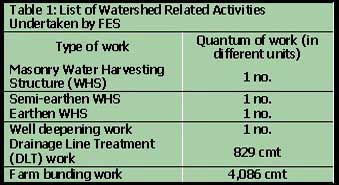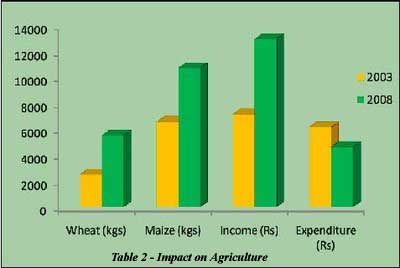Impact of watershed intervention in Dindorkheda village
Jan 20, 2012
Village Profile
Dindorkheda village is part of the Kerwas Panchayat in the Pratapgarh tehsil of the newly formed Pratapgarh district in Rajasthan. It is a predominant tribal village, with a total of 18 households, and a population of 72 (32 females and 40 males). Most farmers are small and marginal farmers with an average land holding size of around 1 ha. The area has good forest cover, with a diversity of forest species and a major portion of the geographical area of the village comprises forestland. The community is dependent on agriculture, forests and wage labour for their livelihood.
The Intervention
 Although agriculture is the primary livelihood for almost all households, agriculture productivity was low on account of inadequate water availability and degradation of common lands further eroding the soil cover. Other factors that contributed to low agriculture output were the lack of information on best practices in agriculture and financial resources for the timely purchase of agricultural inputs.
Although agriculture is the primary livelihood for almost all households, agriculture productivity was low on account of inadequate water availability and degradation of common lands further eroding the soil cover. Other factors that contributed to low agriculture output were the lack of information on best practices in agriculture and financial resources for the timely purchase of agricultural inputs.
The area was once rich in natural resources, but the weakening of institutional arrangements led to a gradual degradation of natural resources. The Foundation for Ecological Security initiated interventions in the village in 2005, with various soil and moisture conservation activities (See Table 1) under an overall watershed development approach. The village formed a watershed development society called the ‘Seetla Mata Jal Grahan Vikas Samiti’, with all villagers as members of the institution. In addition to the implementation of various conservation measures, the community was also made aware of the importance of protecting and sustaining natural resources. In addition, the community took up the management and control of 10 hectares of forest land under Joint Forest Management.
Impact of the Intervention
Increment in biomass, conservation of fertile soil, nutrient and water recycling, and increasing moisture  regimes led to strengthening of forest-water-agriculture inter-linkages. Construction of water harvesting structures led to sufficient availability of water for irrigation, for livestock drinking and household purposes, and which contributed to an increase in crop production and ensured food security. Three Water Harvesting structures (WHS) constructed had a combined total water holding capacity of 40,700 cubic meters helpful in irrigation. In addition to this, soil and moisture conservation work in the form of Farm bunding (4,086 cmt) and Drainage Line Treatment (DLT- 829 cmt), was carried out. Soil and moisture conservation measures have been instrumental in arresting 4,915 cmt of soil being eroded. On the other hand, grass biomass of forestland, which was 2.6 tonnes per hectare soared up to 4.8 tonnes, after project intervention. This was a good indicator of the effectiveness of the conservation work on land and water resources and its impact on various production systems.
regimes led to strengthening of forest-water-agriculture inter-linkages. Construction of water harvesting structures led to sufficient availability of water for irrigation, for livestock drinking and household purposes, and which contributed to an increase in crop production and ensured food security. Three Water Harvesting structures (WHS) constructed had a combined total water holding capacity of 40,700 cubic meters helpful in irrigation. In addition to this, soil and moisture conservation work in the form of Farm bunding (4,086 cmt) and Drainage Line Treatment (DLT- 829 cmt), was carried out. Soil and moisture conservation measures have been instrumental in arresting 4,915 cmt of soil being eroded. On the other hand, grass biomass of forestland, which was 2.6 tonnes per hectare soared up to 4.8 tonnes, after project intervention. This was a good indicator of the effectiveness of the conservation work on land and water resources and its impact on various production systems.
Impact on Agriculture
Moo pahle kabhi socho na ki itna paani hoga, maari kheti hudregi aur moo hau se khetibari karoonga aur hau paya bhi meelega (I had never thought that this much of water would be available and my agricultural produce would increase and I would be able to earn through it ) - Babulal S/o Asharam, Dindorkheda village
A household survey in the village indicated an increment of 20.6 % in the area under double cropping, which can be attributed to the increased availability of water. During the rabi season, a marked change was observed in wheat production (from a total of 25 quintals in 2003, wheat production increased to 55.12 quintals in 2008). Cultivation in the kharif season demonstrated a shift from cotton to soyabean, and an increase in the cultivation of maize from 65.5 quintals in 2003 to 107 quintals in 2008. The increase in maize production has led to an increase in food availability per person. (See Table 2)
These developments resulted in an increment in average income from agriculture from Rs. 7,160 in 2003 to Rs. 12,938 in 2008. At the same time the average expenditure on agriculture reduced from Rs. 6,156 to Rs. 4,625 during the same period.
Inference
Implementing natural resource conservation interventions using the watershed approach contributed directly to improving the water table and agriculture production. Another major socio-economic change was the revival of community institutions and social cohesiveness, which would be a critical factor in sustaining these positive developments.
Contributed by - Foundation for Ecological Security (FES)









